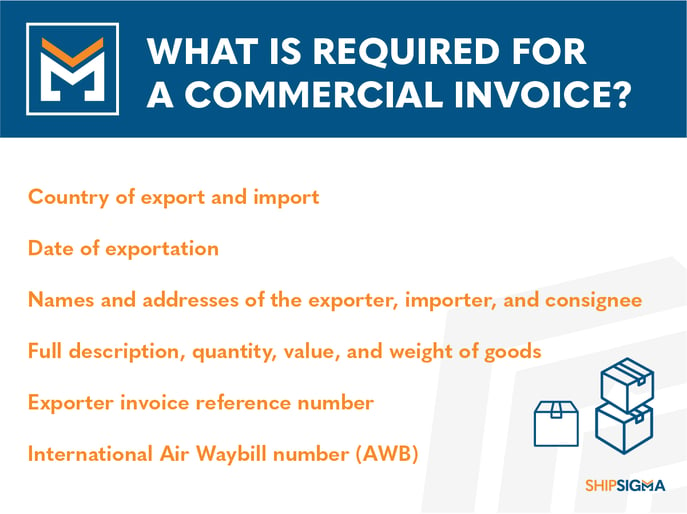FedEx Commercial Invoice Instructions
June 6, 2022 •Deyman Doolittle

With staggering shipping prices, investigating cost-saving measures becomes a necessity rather than just good business practice. Conducting a parcel invoice audit is one strategy to identify any invalid or avoidable charges, such as UPS or FedEx surcharges for peak deliveries or size restrictions. However, exporters should also strive to find solutions before goods are even shipped.
As simple as it may sound, accurately filling out all shipping documents beforehand is a key step in preventing extra shipping costs. For international shipments specifically, a commercial invoice includes many important details to see a shipment successfully through customs and to its intended recipient. To that end, this article will focus on FedEx’s commercial invoice, the purpose of a commercial invoice, and some instructions for filling one out.
What Is a Commercial Invoice for FedEx and Customs?
According to the International Trade Administration, a commercial invoice is a required document in the international importing and exporting clearance process. Its main purpose is to provide necessary information to customs officials, like:
- Country of export and import
- Date of exportation
- Names and addresses of the exporter, importer, and consignee
- Full description, quantity, value, and weight of goods
- Exporter invoice reference number
- International Air Waybill number (AWB)

Depending on which countries the goods are moving between, customs may require additional specifics on a commercial invoice. Customs officials use this information to determine:
- Whether the goods can move in or out of the country
- How much to assess in duties and taxes
- If the goods require additional examination or action
If certain items are not properly filled out on a commercial invoice or other required shipping documents, the shipment could be delayed, seized, forfeited, or returned to the sender. These kinds of shipping issues cause ripple effects in costs.
For businesses looking to ship internationally with FedEx specifically, FedEx has its own commercial invoice PDF. We have put together some guidance on the best practices for filling it out.
How Do You Fill Out a Commercial Invoice for FedEx?
For this guide on commercial invoices, we will specifically focus on FedEx’s commercial invoice form. If an exporter is shipping via a different carrier, they may be able to use a different commercial invoice template, or they might be required to use that carrier’s specific commercial invoice.
Regardless, commercial invoices generally include similar information to this FedEx commercial invoice example, making the following tips for filling one out helpful no matter the carrier.
- Letterhead: It’s always best (and sometimes required) for a commercial invoice to be on company letterhead. The FedEx commercial invoice has a space in the top-left corner of the document specifically for this purpose.
- International Air Waybill (AWB) Number: An international AWB is a document that travels with shipped goods, allowing the shipment to be tracked and providing detailed information about the shipment. An AWB number, or “shipping number,” is the tracking number associated with a shipment. FedEx’s AWB number is 12 digits.
- Consignee: This is the person or entity that must be present to accept a shipment and usually pays import duties and taxes. The consignee can sometimes be the exporter, the importer, or occasionally neither if freight forwarding is involved and a recipient is not the final buyer of the goods. If the importer and consignee are the same, the importer section can be left blank.
- Exporter/Importer Information: A commercial invoice must include the name and address of both the shipping company (the exporter) and the recipient (the importer). It’s best to include additional contact information (i.e. a phone number or email address), as well as a tax ID number when applicable.
- Export References: This section is the perfect place to add any internal tracking information the exporter wants to include, like an order or invoice number.
- Quantity: Quantity is fairly straightforward, but be sure to list separate quantities for each good included in one shipment.
- Full Description of Goods: The word “full” here is key, as all goods descriptions should be detailed and consistent. For example, a furniture part manufacturer shouldn’t just say “chair parts” but instead list the exact parts, such as “Three 12 cm office chair cylinders” or “Seven padded, polyurethane armrests.” If model numbers or brand names are involved, it’s best to include those details as well.
- Harmonized System (HS) Code: An HS Code is a standardized numerical method of classifying traded products. This code allows the identification of products for duty and tax assessment. The U.S. Census Bureau has a searchable database to assist with classifying products and getting the proper HS code. If a shipment contains any goods that have a corresponding HS code, the HS code should be included in the product description.
- Unit Value: The unit value should be equal to the market price of each good, and it should also include the currency. A value that does not seem to match the product description will usually lead to customs officials requesting evidence of the stated value.
- Signature: Once the document has been filled out and double-checked, be sure to sign and date the bottom of the form to ensure its validity.
Verifying commercial invoice accuracy is certainly one way to ensure cost-effective shipping. For companies looking for additional solutions, there are many other actionable steps that combat shipping spend inefficiencies.
Find More Ways to Cut Shipping Costs with ShipSigma
Our ShipSigma team is so familiar with FedEx practices because our staff includes former employees from UPS and FedEx, giving us insider knowledge to decrease shipping costs for our clients. After a thorough parcel invoice audit, we focus on looking at FedEx shipping exceptions, automatic billing error refunds, carrier contract negotiations, and shipping optimization for small parcel and freight. Using these unique insights and other shipping analytics, ShipSigma can skillfully guide your company through shipping negotiations and assist you with maintaining the resulting savings over time.
With these long-term cost efficiencies born from data and technology, we find our clients have an average cost savings of around 25%. From avoiding unnecessary UPS or FedEx surcharges to big-picture saving techniques, ShipSigma can help you do it all. If you’d like to see these savings and increased profit margins for your business, try our services for free today.

